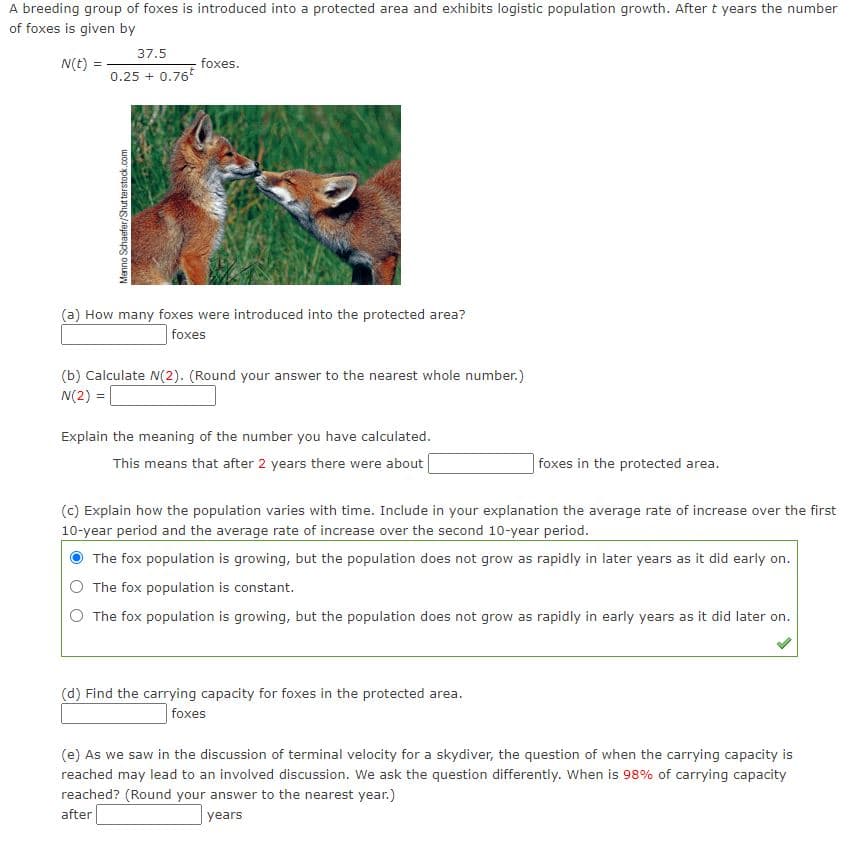A breeding group of foxes is introduced into a protected area and exhibits logistic population growth. After t years the number of foxes is given by 37.5 N(t) = - foxes. 0.25 + 0 0.76 (a) How many foxes were introduced into the protected area? foxes (b) Calculate N(2). (Round your answer to the nearest whole number.) N(2) = Explain the meaning of the number you have calculated. This means that after 2 years there were about foxes in the protected area. (c) Explain how the population varies with time. Include in your explanation the average rate of increase over the first 10-year period and the average rate of increase over the second 10-year period. The fox population is growing, but the population does not grow as rapidly in later years as it did early on. The fox population is constant. O The fox population is growing, but the population does not grow as rapidly in early years as it did later on. Menno Schaefer/Shut terstock.com
A breeding group of foxes is introduced into a protected area and exhibits logistic population growth. After t years the number of foxes is given by 37.5 N(t) = - foxes. 0.25 + 0 0.76 (a) How many foxes were introduced into the protected area? foxes (b) Calculate N(2). (Round your answer to the nearest whole number.) N(2) = Explain the meaning of the number you have calculated. This means that after 2 years there were about foxes in the protected area. (c) Explain how the population varies with time. Include in your explanation the average rate of increase over the first 10-year period and the average rate of increase over the second 10-year period. The fox population is growing, but the population does not grow as rapidly in later years as it did early on. The fox population is constant. O The fox population is growing, but the population does not grow as rapidly in early years as it did later on. Menno Schaefer/Shut terstock.com
Chapter5: Exponential And Logarithmic Functions
Section5.5: Exponential And Logarithmic Models
Problem 30E: The table shows the mid-year populations (in millions) of five countries in 2015 and the projected...
Related questions
Concept explainers
Contingency Table
A contingency table can be defined as the visual representation of the relationship between two or more categorical variables that can be evaluated and registered. It is a categorical version of the scatterplot, which is used to investigate the linear relationship between two variables. A contingency table is indeed a type of frequency distribution table that displays two variables at the same time.
Binomial Distribution
Binomial is an algebraic expression of the sum or the difference of two terms. Before knowing about binomial distribution, we must know about the binomial theorem.
Topic Video
Question
7

Transcribed Image Text:A breeding group of foxes is introduced into a protected area and exhibits logistic population growth. After t years the number
of foxes is given by
37.5
N(t)
foxes.
0.25 + 0.76
(a) How many foxes were introduced into the protected area?
foxes
(b) Calculate N(2). (Round your answer to the nearest whole number.)
N(2)
Explain the meaning of the number you have calculated.
This means that after 2 years there were about
foxes in the protected area.
(c) Explain how the population varies with time. Include in your explanation the average rate of increase over the first
10-year period and the average rate of increase over the second 10-year period.
The fox population is growing, but the population does not grow as rapidly in later years as it did early on.
The fox population is constant.
O The fox population is growing, but the population does not grow as rapidly in early years as it did later on.
(d) Find the carrying capacity for foxes in the protected area.
foxes
(e) As we saw in the discussion of terminal velocity for a skydiver, the question of when the carrying capacity is
reached may lead to an involved discussion. We ask the question differently. When is 98% of carrying capacity
reached? (Round your answer to the nearest year.)
after
|years
Menno Schaefer/Shut terstock.com
Expert Solution
This question has been solved!
Explore an expertly crafted, step-by-step solution for a thorough understanding of key concepts.
This is a popular solution!
Trending now
This is a popular solution!
Step by step
Solved in 3 steps

Knowledge Booster
Learn more about
Need a deep-dive on the concept behind this application? Look no further. Learn more about this topic, advanced-math and related others by exploring similar questions and additional content below.Recommended textbooks for you







Algebra & Trigonometry with Analytic Geometry
Algebra
ISBN:
9781133382119
Author:
Swokowski
Publisher:
Cengage

Trigonometry (MindTap Course List)
Trigonometry
ISBN:
9781337278461
Author:
Ron Larson
Publisher:
Cengage Learning